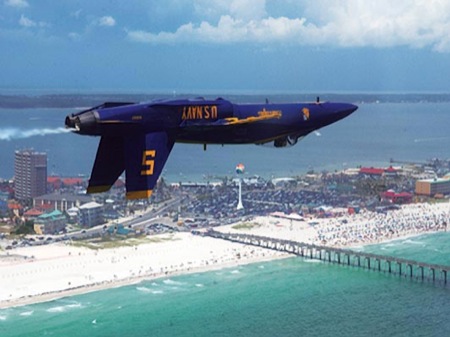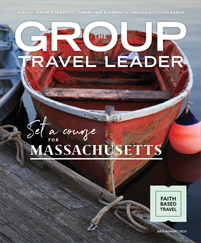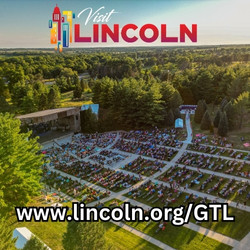
Courtesy Pensacola Bay Area CVB
If you are willing to climb the 177 steps to the top of the historic Pensacola Lighthouse, you will be in for an amazing treat.
“We are home to the Navy’s Blue Angels, and when they do their practice show, they fly over the base and buzz the lighthouse,” said Lori Coppels, group sales manager for the Pensacola Bay Area Convention and Visitors Bureau. “The top of the tower is open, and you get a really great look. They are pretty much at eye level. You are up in the air with them.”
The contrast between the nearly 153-year-old brick lighthouse and the modern blue-and-gold F/A-18 Hornet fighter jets flown by the Navy’s crack precision flying team is a microcosm of Pensacola, Fla., where the old and historic coexist in comfortable harmony with contemporary progress.
That combination, along with 52 miles of soft, white-sand beaches and Naval Air Station Pensacola, site of one of the largest aviation museums in the world, gives Pensacola a strong, multiprong marketing angle and plenty of reasons for groups to visit.
“Mainly how we market is our history, beaches and military base,” said Coppels.
Situated in the northwest corner of Florida along the Gulf of Mexico, Pensacola was founded in 1559 by Spaniard Don Tristan de Luna. The short-lived settlement, which was abandoned a short time later after a hurricane destroyed its supplies, was the first European settlement in the present-day United States.
Over the years, Pensacola has been ruled by Spain, France, England, the Confederate States of America and the United States, leading to its moniker as “The City of Five Flags.”
Everybody loves a lighthouse
The lighthouse, located on the naval air station across the street from the National Naval Aviation Museum, still casts a beam 27 miles into the Gulf and is the fourth-tallest brick lighthouse in the nation.
“It still has its original lens,” said Coppels. “It is now open seven days a week for tours. It is even open for night tours and full-moon tours. Standing there in front of the lighthouse looking across the bay is absolutely gorgeous.”
The top of the 160-foot-tall tower holds only 15 to 17 people at a time, so Coppels recommended making reservations for the Blue Angels flyovers.
The Blue Angels, based at the naval air station, practice each week from March to November.
“They fly Tuesday and Wednesday mornings at 8:30 a.m. sharp,” said Laura Lee, media and public relations manager for the CVB. “You can watch from behind the museum; they have bleachers, but the really cool place is the lighthouse.”
Downtown Pensacola is bustling with scores of new shops, restaurants and cafes, many in restored historic buildings. The new $54 million, 30-acre Maritime Park, which will feature a new baseball stadium for the Cincinnati Reds’ Double-A farm team, the Blue Wahoos, will open in the spring.
“Our downtown has this historic feel but also is very progressive,” said Lee.
Also in downtown is Historic Pensacola Village, which preserves more than 20 properties, including 11 that are open to the public.
The T.T. Wentworth Jr. Florida State Museum, which has many artifacts and exhibits about the city’s history, is in the century-old, elaborate Renaissance-revival building that originally was city hall; the Pensacola Historical Museum, which has exhibits about early American Indians, and military and maritime history, is in a restored 1882 former saloon.











